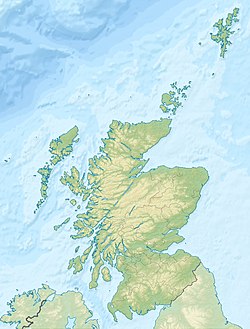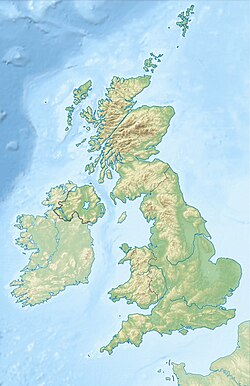Heart of Neolithic Orkney is a group of Neolithic monuments on the Mainland of the Orkney Islands, Scotland. The name was adopted by UNESCO when it proclaimed these sites as a World Heritage Site in December 1999.
| UNESCO World Heritage Site | |
|---|---|
 Excavated dwellings at Skara Brae, Europe's most complete Neolithic village. | |
| Location | Orkney, Scotland |
| Includes | |
| Criteria | Cultural: (i), (ii), (iii), (iv) |
| Reference | 514bis |
| Inscription | 1999 (23rd Session) |
| Extensions | 2015 |
| Area | 15 ha (37 acres) |
| Buffer zone | 6,258 ha (15,460 acres) |
| Coordinates | 58°59′38.6″N 3°12′29.0″W / 58.994056°N 3.208056°W |
The site of patrimony currently consists of four sites:
- Maeshowe – a chambered cairn and passage grave, aligned so that its central chamber is illuminated on the winter solstice. It was looted by Vikings who left one of the largest collections of runic inscriptions in the world.[1]
- Standing Stones of Stenness – the four remaining megaliths of a henge, the largest of which is 6 metres (19 ft) high.[2][3]
- Ring of Brodgar – a stone circle 104 metres in diameter, originally composed of 60 stones set within a circular ditch up to 3 metres deep and 10 metres wide, forming a henge monument. It has been estimated that the structure took 80,000 man-hours to construct.[4][5]
- Skara Brae – a cluster of eight houses making up Northern Europe’s best-preserved Neolithic village.[6]

Ness of Brodgar is an archaeological site between the Ring of Brodgar and the Stones of Stenness that has provided evidence of housing, decorated stone slabs, a massive stone wall with foundations, and a large building described as a Neolithic "cathedral".[7][8] Although it is not part of the World Heritage Site, the Ness of Brodgar "contribute[s] greatly to our understanding of the WHS" according to Historic Scotland, which manages most of the site.[9]
In 2008, UNESCO expressed concern about plans by the local council to "erect three large 72 metres wind turbines to the north-west of the Stones of Stenness and the Ring of Brogdar" that might damage the site.[10] In 2019, a risk assessment was performed to assess the site's vulnerability to climate change. The report by Historic Environment Scotland, the Orkney Islands Council and others concludes that the entire World Heritage Site, and in particular Skara Brae, is "extremely vulnerable" to climate change due to rising sea levels, increased rainfall and other factors; it also highlights the risk that Skara Brae could be partially destroyed by one unusually severe storm.[11]
The first application of the Climate Vulnerability Index to a Cultural World Heritage property took place at the Heart of Neolithic Orkney in April 2019.[12]
See also
editReferences and footnotes
edit- General references
- Wickham-Jones, Caroline (2007). Orkney: A Historical Guide. Edinburgh: Birlinn. ISBN 9781841585963.
- Specific references and notes
- ^ "Maeshowe" Archived 16 June 2017 at the Wayback Machine. Orkneyjar. Retrieved 11 February 2008.
- ^ "The Standing Stones o' Stenness" Archived 7 June 2017 at the Wayback Machine. Orkneyjar. Retrieved 16 September 2008.
- ^ Wickham-Jones (2007) p. 28.
- ^ " The Ring o' Brodgar, Stenness " Archived 15 July 2017 at the Wayback Machine. Orkneyjar. Retrieved 16 September 2008.
- ^ Wickham-Jones (2007) pp. 28–29.
- ^ "Skara Brae Prehistoric Village" Historic Scotland. Retrieved 16 August 2009.
- ^ Towrie, Sigurd (16 August 2007) "Stone wall hints at Neolithic spiritual barrier " Archived 27 April 2017 at the Wayback Machine Orkneyjar. Retrieved 10 September 2014.
- ^ Ross, John and Hartley, David (14 August 2009) " 'Cathedral' as old as Stonehenge unearthed." Edinburgh. The Scotsman. Retrieved 16 August 2009.
- ^ Heart of Neolithic Orkney - Management Plan 2014–19: Consultation Draft (PDF). Historic Scotland. 2013. p. 10. Archived from the original (PDF) on 6 June 2014. Retrieved 4 June 2014.
- ^ "Heart of Neolithic Orkney". Retrieved 30 May 2014.
- ^ James Cook (2 July 2019). "Orkney world heritage sites threatened by climate change". BBC. Retrieved 8 July 2019.
- ^ Jones, R.H.; Davies, M.H.; Day, J.C.; Heron, S.F. (2022). "Developing Climate Risk Assessments for World Heritage: the Climate Vulnerability Index". Internet Archaeology (60). doi:10.11141/ia.60.3.

